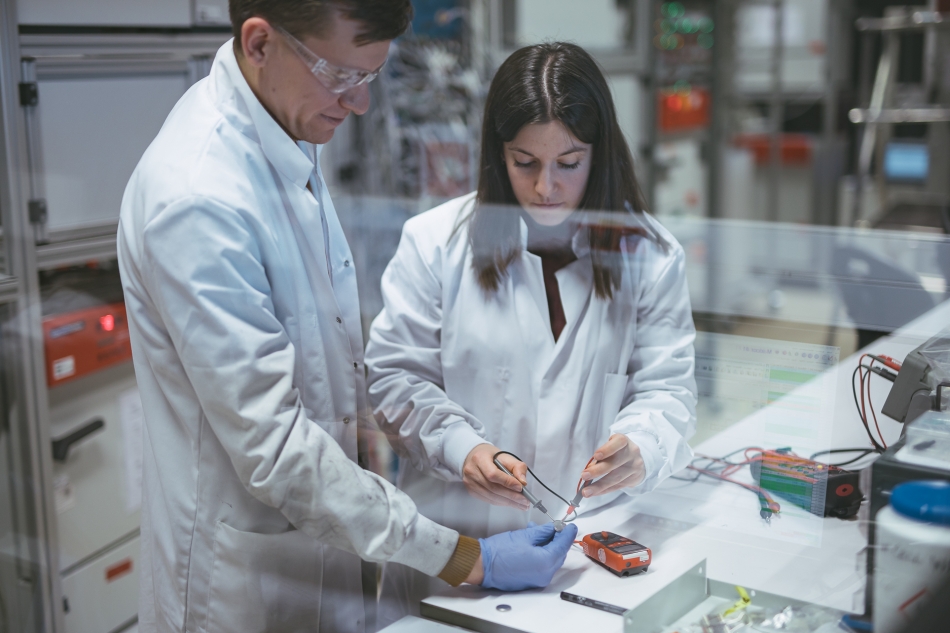
Vision & Concept
The rising energy demand and reliance on fossil fuels have accelerated climate change, with road transport contributing three-quarters of transport-related GHG emissions. Decarbonizing this sector is key to climate neutrality, with BEVs playing a crucial role. SOLIDBAT addresses this challenge by developing a disruptive solid-state battery (SSB) technology focused on high energy density, fast charging, long life, and safety.


SOLIDBAT CONTEXT
The battery market is currently dominated by rechargeable Li-ion batteries (LIBs). However, their energy density is well below the Electric Vehicle (EV) sector demands, and the use of flammable organic liquid electrolytes carries a severe safety risk. Lithium metal (LiM) as anode has emerged as the most promising alternative to graphite anodes in current LIBs due to its ten times higher theoretical capacity. Nevertheless, the high reactivity of LiM implies serious security hazards when combined with a highly flammable liquid electrolyte. For this reason, the deployment of LiM anodes requires a shift towards safer electrolytes, such as solid-state electrolytes (SSEs). LiM polymer batteries have been successfully implemented in EVs by Blue Solutions, evidencing the potential application of this technology. Nonetheless, the performance provided by these batteries is still far from meeting the targeted energy density and cyclability.
The main obstacle to introduce SSBs to the industrial level are the manufacturability of the LiM anode, the lack of self-standing SSE providing sufficient ionic conductivity and electrochemical stability and the final cost of the battery. Based on these results and limitations, SOLIDBAT will build an advanced solution for SSB materials and prototypes that will enable achieving a scalable technology with performances and costs compatible with transportation markets.

PROJECT
SOLIDBAT targets a new SSB technology delivering high energy density (>400 Wh/kg, 1000 Wh/L), high rate-capability, and long cyclability, and improving at the same time safety, cost and recyclability for an optimised environmental and climate impact. The SOLIDBAT cell will consist of a high-capacity Ni-rich (Li(Ni0.8Mn0.1Co0.1)O2, NMC811) coated cathode active material (CAM), a high-energy 3D structured LiM anode, and a highly performant single Li-ion conductive Hybrid Gel Polymer Electrolyte (HGPE). Moreover, SOLIDBAT incorporates from the design stage a strong awareness for sustainability, recycling, and environmental impact. The use of critical raw materials will be reduced, and a greener manufacturing process will be developed avoiding the use of organic solvents (such as irritant and reproductive toxic N-Methyl-2-pyrrolidone, NMP). The recycling of each component will be considered during all steps, starting from the preliminary materials’ selection all the way to the final cell design. Thanks to these innovative crosscutting solutions, combined with an automated and scalable manufacturing concept, SOLIDBAT will contribute to the energy and transport transition towards climate neutrality.

OBJECTIVES
SOLIDBAT aims to demonstrate a replicable (TRL6) solid-state battery technology that meets EV performance and cost requirements safely and sustainably, driving adoption. A skilled consortium covering the battery value chain supports this effort. By 2030, SOLIDBAT will achieve 1000 cycles at 80% DoD, >450 Wh/kg energy density, 1200 Wh/L, and a cost of 75 €/kWh at pack level. Its cell components and manufacturing process will align with EU sustainability, safety, and recyclability standards.
These are the main objectives:
- Define solid-state battery cell and tests according to end-user requirements.
- Develop models and digital tools for material and cell design.
- Develop an industrially compatible and high-performance hybrid gel polymer electrolyte.
- Develop a structured thin lithium metal anode.
- Design a water-borne high loading NMC cathode.
- Understand interfacial interactions in SSBs enabling the tailored design of stable interfaces.
- Scale-up of all SSB components up to TRL6.
- Demonstrate processability of SSBs up to TRL6 with 5 Ah cells.
- Develop models to predict electrochemical performance and aging.
- Validate safety, performance and repeatability of SOLIDBAT technology.
- Design a sustainable industrial processing method.
- Demonstrate industrial, economic and business feasibility.
SOLIDBAT PROJECT’S IMPACT
Competitive and sustainable batteries are urgently needed to accelerate the transition towards a climate-neutral economy, industry, and society. SOLIDBAT is expected to boost the introduction of Gen 4b technology into the market surpassing the key performance indicators of current LIBs in the market while maintaining the intrinsic safety of solid-state technology. SOLDIBAT impact can be divided in three main pillars:
- AD-HOC MATERIALS AND INTERFACES DESING DELIVERING A RELIABLE SSB TECHNOLOGY: The selection of solid-state cell components and architecture meeting, by the end of the project, all performance indicators at ambient and operational temperatures necessary for mobility.
- PROTOTYPES DEVELOPMENT AT RELEVANT INDUSTRIAL ENVIRONMENT: Cell manufacturing processes which allow the fabrication of performant, reliable, sustainable, and affordable solid-state cells, demonstrated at industrial pilot level, with a competitive cost towards 75 €/kWh at pack level by 2030.
- SUSTAINABILITY: Optimised environmental footprint of cell materials (carbon footprint, quantity of metals). Cell materials and designs which are compatible with a recycling process that respects the requirements as put forward in the Batteries Regulation.
TIMELINE
The following timeline sets out the main milestones of the SOLIDBAT project.
-
01/04/2025
Recommendation on 1st selection of materials
-
01/05/2025
Delivery of first generation of battery materials and components
-
01/11/2025
Preliminary sustainability assessment
-
01/05/2026
Development of optimized battery materials and components
-
01/07/2026
50 monolayer pouch cells
-
01/11/2026
Electrolyte and electrodes in kg and meters scale for 1 Ah cells
-
01/05/2027
1 Ah solid-state cells
-
01/06/2027
Electrolyte and electrodes in kg and meters scale for 5 Ah solid-state cells
-
01/07/2027
LCA and LCC data collection
-
01/11/2027
First assessment of 1 Ah solid-state cells to provide feedback to 5 Ah cells cycling definition
-
01/02/2028
5 Ah solid-state cells
-
01/06/2028
Mini-module for safety evaluation
-
01/09/2028
Exploitation roadmap and follow-up strategies in place